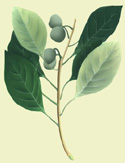| Latin Name | Terminalia bellirica Roxb. (Combretaceae) |
| English Name | Belliric myrobalan |
| Sanskrit Names | Vibhitaki, Karshaphala, Kalidruma |
| Hindi Name | Bahera |
 History: This tree, called Vibhitaki in Sanskrit, meaning fearless, is avoided by the Hindus of Northern India, who will not sit in its shade as it is supposed to be inhabited by demons. As long as the influence of Arabian medicine prevailed, it was used medicinally in Europe, having been introduced by the Arabs from India. Distribution: Found in deciduous forests throughout the greater part of India, but not in the arid regions. Habit: A tall tree, with characteristic bark. The stems are straight, frequently buttressed when large; the leaves, broadly elliptic, clustered towards the ends of branches; the flowers are solitary, simple, axillary spikes; the fruits, are globular and obscurely 5-angled. Principle constituents: ß- sitosterol, gallic acid, ellagic acid, ethyl gallate, galloyl glucose, chebulagic acid. Indications: The fruit possesses antibacterial properties. It is employed in dropsy, piles and diarrhea. While using herbal eye drops containing T. bellirica, encouraging results have been obtained in cases of myopia, corneal opacity, pterigium, immature cataract, chronic and acute infective conditions. The fruit possesses myocardial depressive activity. Product range: Mentat, Pilex, Ophthacare, Gasex, Lukol, V-Gel, Vegecort |
|